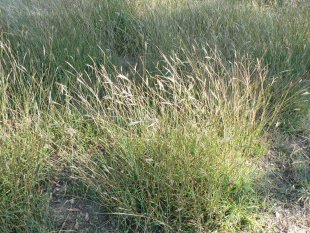
Red grass
SCIENTIFIC NAME: Bothriochloa macra
CATEGORY: C4 perennial
IDENTIFICATION TIPS
- Tufted, warm season perennial grass to 1m tall
- Leaves generally grow quite flat to the ground, especially when grazed
- Leaves and stems often reddish or purplish, especially after frost. Nodes are red and hairless
- Seedhead consists of 2-4 erect branches (3-8cm long) pressed close together. Seeds are awned
- Flowers in summer and autumn
CLIMATIC & SOIL REQUIREMENTS
- Wide tolerance of soil types and fertility types, except for very acid soils (pHCa < 4.2)
- Highly drought tolerant, but frost sensitive
GRAZING & NUTRITIONAL VALUE
- Moderate grazing value, but low when frosted
- Digestibility ranges from 48-69 %
- Crude protein 4-15 %
MANAGEMENT STRATEGIES
- Tolerates disturbance; one of the first native plants to return to drought affected sown pastures
- A valuable coloniser of degraded areas and for useful for stabilising waterways
- Can produce a large amount of material, the majority of which is stem. However, it can provide quality feed after summer rain and is best utilised at this time
- Responsive to fertiliser and increased grazing pressure, but grows well in unfertilised areas
- Best kept green and leafy as it has a high stem to leaf ratio when flowering and stock tend to avoid it once it goes to seed; rotational grazing helps maintain larger plants
- Maintain heavier grazing from late winter to mid spring to avoid clover and annual grass dominance in spring or red grass populations can thin out dramatically
- To increase density, allow to seed in summer and rest pastures in late summer to aid seed germination if conditions are suitable
- Seed can be sown by spreading seed-bearing hay or broadcasting and harrowing in spring or early autumn
SIMILAR PLANTS
- Red grass (Bothriochloa decipiens) is similar in most ways and close inspection of the spikelet is required to distinguish it.
- Kangaroo grass (Themeda australis) is vegetatively similar, but has folded new leaves and a spatheate seedhead
- Queensland bluegrass (Dichanthium sericeum) has much hairier seedheads and stem nodes
- Silky browntop (Eulalia aurea) seedheads are covered in dense, reddish-brown hairs

(Stemmy appearance of lightly grazed plants: W Brown)

